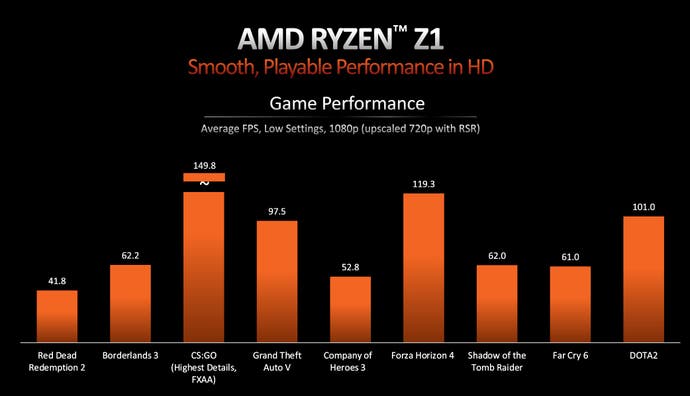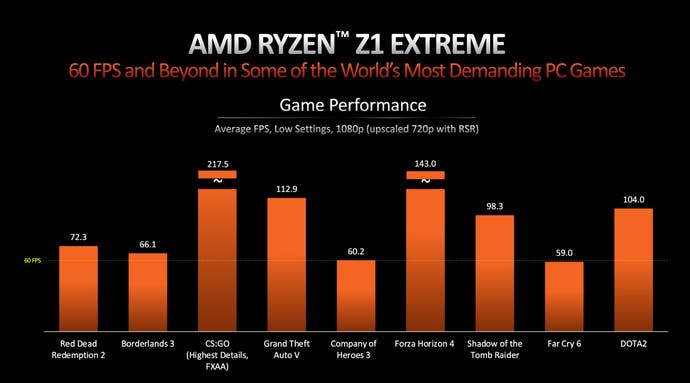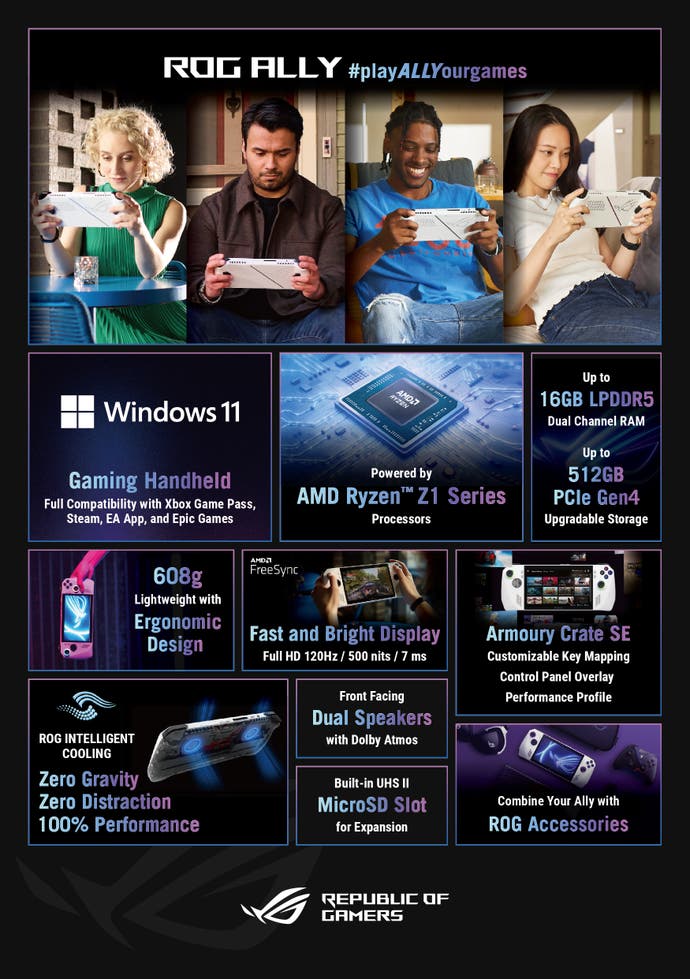Asus reveals more details on its Ryzen Z1 powered ROG Ally handheld PC
Faster than Steam Deck with a 120Hz screen - but how much does it cost?
After its initial reveal on April 1st this year, Asus is finally ready to shed more light on its ROG Ally handheld gaming PC, which launches on May 11th and will be sold by Currys in the UK. The Steam Deck competitor looks to be a more premium device than Valve's offering, with a faster AMD Ryzen Z1 series processor, seven-inch 1080p 120Hz touch screen and Windows 11 - but no price has yet been announced.
The hardware side of the equation is perhaps the most fascinating, so let's begin there. The Ally is powered by a 'custom' Ryzen Z1 chipset that includes Zen 4 CPU cores and RDNA 3 graphics produced on a 4nm node. (By comparison, current Ryzen 7000 desktop designs use a mixture of 5nm and 6nm processes, which should give the Ally's APU an advantage in terms of performance per watt.) We expect to see configurations of the device featuring the Z1 (6C/12T, 22MB cache, 2.8TF 4CU GPU) and Z1 Extreme (8C/16T, 24MB cache, 8.6TF 12CU GPU) processors announced by AMD earlier today, offering increasing levels of horsepower for a higher asking price.
Speaking of which, the impressive-looking APU is backed with 16GB of LPDDR5 RAM in dual-channel mode, while storage is up to a 512GB PCIe 4.0 SSD and UHS-2 Micro SD card expansion - faster than what is available on the Deck, which is limited to PCIe 3.0 storage and UHS-1 Micro SD cards. Wi-Fi 6E is also included, in comparison to WiFi 5 on Steam Deck. It'll be interesting to see whether all SKUs of the Ally come with the full complement of RAM and storage, or whether this will be pared back on the cheaper options.
In terms of design, Asus says that the Ally has taken shape over five years of iterations, ultimately reaching a 608g weight (vs the Steam Deck's 669g) with aluminium internals, twin fans, 'anti-gravity heat pipes', and tons of custom components to ensure a good balance of performance and portability. The Xbox-style button layout is bolstered by additional paddles on the back of the device, so Asus is taking a similar approach to Valve here - albeit with no trackpads. As with its ROG Phone models, accessories are also a focus, with Asus showing off its ROG XG Mobile external GPU - plus a case, controller, charger and low-latency wireless in-ear headphones. Presumably an attachable cooler is also in the offing!
I dig what Asus has done here with the design, with a device that very much fits the brand's sci-fi aesthetic with angular lines and plenty of RGB - but perhaps a plain black version would be preferable for folks that want to fly under the radar a bit in public settings.



The IPS screen looks like a major differentiating factor compared to the Steam Deck, with a higher-res 1080p resolution, 120Hz refresh rate and impressive 500 nits of peak brightness. The display is also rated for a good but not great 7ms pixel response time, 1000:1 contrast ratio and full coverage of the sRGB colour space. It's not OLED though, which is a bit of a disappointment on a premium device.
Even with a more powerful CPU, maxing out both resolution and refresh rate seems unlikely, especially when battery life is a concern, but you're at least unlikely to be limited by the display. Adaptive sync is also supported, which is particularly helpful on a mobile APU that's probably more likely to deliver performance below 60fps in graphically-demanding titles - the ability to smooth out uneven frame-rates is certainly nice to have.

While the Steam Deck is geared towards the Steam marketplace, for obvious reasons, it is possible to add other launchers fairly easily by diving into the Linux-based SteamOS desktop mode of the device. With its ROG Armoury Crate meta-launcher built on a Windows 11 base, the Ally is aiming to make a broader range of stores easier to get running, with compatibility with Steam, Epic Games, Xbox Game Pass, EA Play, Ubisoft Connect and Battle.net all mentioned in the Taiwanese firm's marketing materials. The app also includes gamepad, keyboard/mouse mapping and desktop modes, RGB controls and a Deck-style on-screen display that looks a little more advanced than we've seen from the likes of Aya Neo devices.
The ROG Ally comes with a three-month Xbox Game Pass Ultimate subscription, which is a sensible way of making the most of that Windows backend and providing access to a ton of excellent games right off the bat - although the Microsoft Store doesn't offer anywhere near the handheld-friendly curation (or even stability) provided by Steam. There are signs that Microsoft is taking handhelds like the Steam Deck and Aya Neo seriously, with an internal hackathon demonstrating a handheld-focused UI amongst other changes, so I hope that extends towards making it easier to find handheld-appropriate titles on the Xbox and Windows Store apps in future.
Overall, the ROG Ally is shaping up to be an exciting release and we're looking forward to getting our hands on one to test out its performance - as well as learning exactly how much it'll cost when it launches on May 11th. If Asus is able to deliver the device at a similar price to the Steam Deck, or offer a premium model that is significantly better, it could have a winner on its hands.





